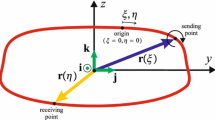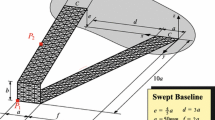Abstract
An invariant procedure for the minimization of induced drag of generic biwings and closed systems (Joined Wings) was presented in the companion paper (minimum induced drag theorems for Joined Wings, closed systems, and generic biwings: theory) and is now adopted to study several theoretical open questions regarding these configurations. It is numerically verified that a quasi-closed C-wing presents the same optimal induced drag and circulation of the corresponding closed system. It is also verified that when the two wings of a biwing are brought close to each other so that the lifting lines identify a closed path, the minimum induced drag of the biwing is identical to the optimal induced drag of the corresponding closed system. The optimal circulation of this case differs from the quasi-closed C-wing one by an additive constant. The non-uniqueness of the optimal circulation for a closed wing system is also addressed, and it is shown that there are an infinite number of equivalent solutions obtained by adding an arbitrary constant to a reference optimal circulation. This property has direct positive impact in the design of Joined Wings as far as the wing load repartition is concerned: The percentage of aerodynamic lift supported by each wing can be modified to satisfy other design constraints, and without induced drag penalty. Finally, the theoretical open question regarding the asymptotic induced drag behavior of Joined Wings, when the vertical aspect ratio approaches infinity, has been resolved. It has been shown that for equally loaded wings indefinitely distant from each other, the boxwing minimum induced drag tends to zero. In that condition, the upper and lower wings present a constant aerodynamic load. Prandtl’s approximated formula for the minimum induced drag of a boxwing (Best Wing System) cannot be used to describe the asymptotic behavior. This work also shows that the optimal distribution over the equally loaded horizontal wings of a boxwing is not the superposition of a constant and an elliptical functions. This is an acceptable approximation only for small vertical aspect ratios (of aeronautical interest).
























Similar content being viewed by others
Notes
Closed System’s C-Wing Limit and Closed System’s Biwing Limit Theorems have not been completely proven in mathematical terms (see [13, 14]); however, they have been numerically verified. Therefore, from a mathematical point of view they are still conjectures. In the following, “Theorem” will mean a conjectured theorem when referred to CSCWLT and CSBLT.
The induced drag minimization is carried out by projecting the lifting system on a single plane perpendicular to the freestram (Munk’s stagger theorem).
References
Prandtl, L.: Induced drag of multiplanes. National Advisory Committee for Aeronautics, Technical Note No. 182, From Technische Berichte, vol. III, no. 7, pp. 309–315 (1924)
Demasi, L., Dipace, A., Monegato, G., Cavallaro, R.: Invariant formulation for the minimum induced drag conditions of non-planar wing systems. AIAA J. 52(10), 2223–2240 (2014). doi:10.2514/1.J052837
Demasi, L.: A theoretical investigation on the conditions of minimum induced drag of closed wing systems and c-wings. J. Aircr. 44, 81–99 (2007)
Kroo, I.: Nonplanar wing concepts for increased aircraft efficiency. In: VKI Lecture Series on Innovative Configurations and Advanced Concepts for Future Civil Aircraft, 6–10 June 2005. https://store.vki.ac.be/lecture-series-monographs/transport/innovative-configurations-and-advanced-concepts-for-future-civil.html
Von Karman, T., Burgers, J.M.: General aerodynamic theory- perfect fluids. In: Durand, W.F. (ed.) Aerodynamic Theory, vol. II, pp. 201–222. Springer, Berlin (1935)
Letcher Jr, J.S.: V-wings and diamond ring-wings of minimum induced drag. J. Aircr. 9, 605–607 (1972)
Cone, C.D.: The theory of induced lift and minimum induced drag of nonplanar lifting systems. Technical Report, NASA, (1962)
DeYoung, J.: Induced drag ideal efficiency factor of arbitrary lateral-vertical wing forms. NASA Contractor Report 3357 (1980)
Jansen, P., Perez, R.E., Martins, J.R.R.A.: Aerostructural optimization of nonplanar lifting surfaces. J. Aircr. 47, 1490–1503 (2010)
Frediani, A., Montanari, G.: Best wing system: an exact solution of the prandtl’s problem. In: Variational Analysis and Aerospace Engineering. Springer Optimization and Its Applications, vol. 33, pp. 183-211. Springer, New York (2009). doi:10.1007/978-0-387-95857-6_11
Frediani, A., Montanari, G., Pappalardo, M.: Sul problema di prandtl della minima resistenza indotta di un sistema portante. In: Congress AIDAA, Turin, 15–19 November 1999, pp. 267–278 (1999)
Rizzo, E.: Optimization Methods Applied to the Preliminary Design of Innovative, Non Conventional Aircraft Configurations. Edizioni ETS, Pisa (2009). ISBN 978-884672458-8
Demasi, L., Monegato, G., Dipace, A., Cavallaro, R.: Minimum induced drag theorems for joined wings, closed systems, and generic biwings: theory. In: AIAA SCITECH, Gaylord Palms and Convention Center, Kissimmee, FL, 5–9 January 2015
Demasi, L., Monegato, G., Dipace, A., Cavallaro, R.: Minimum induced drag theorems for joined wings, closed systems, and generic biwings: Theory. J. Optim. Theory Appl. (2015, in press) doi:10.1007/s10957-015-0849-y
Drela, M.: athena vortex lattice (Avl). http://web.mit.edu/drela/Public/web/avl/ (2007)
Rizzo, E., Frediani, A.: Application of optimisation algorithms to aircraft aerodynamics. In: Buttazzo, G., Frediani, A. (eds.) Variational Analysis and Aerospace Engineering, Springer Optimization and Its Applications, pp. 419–446. Springer, New York (2009). doi:10.1007/978-0-387-95857-6
Addis, B., Locatelli, M., Schoen, F.: Local optima smoothing for global optimization. Optim. Methods Softw. 20, 437 (2005)
Demasi, L.: Induced drag minimization: a variational approach using the acceleration potential. J. Aircr. 43, 669–680 (2006)
Author information
Authors and Affiliations
Corresponding author
Rights and permissions
About this article
Cite this article
Demasi, L., Monegato, G., Rizzo, E. et al. Minimum Induced Drag Theorems for Joined Wings, Closed Systems, and Generic Biwings: Applications. J Optim Theory Appl 169, 236–261 (2016). https://doi.org/10.1007/s10957-015-0850-5
Received:
Accepted:
Published:
Issue Date:
DOI: https://doi.org/10.1007/s10957-015-0850-5




